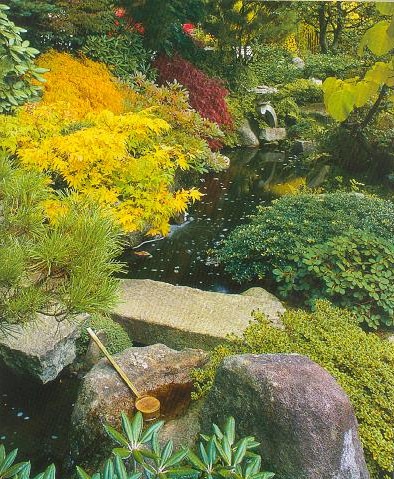

Planning Pointers
Not only are streams and waterfalls attractive features in a pond, but they also aerate the water, providing additional oxygen for fish and other pond life. This section of water features presents various design options and some directions for installing a simple series of cascading falls and pools.


Planning Pointers
Waterfalls can imitate the streams and cascades found in nature, or they can be formal in design. In both formal and informal ponds, waterfalls usually consist of a series of small pools or catch basins linked by low cascades. Building a successful watercourse is largely a matter of trial and error. To create the effct you want, you will have to experiment with different sizes and shapes of rocks, as well as their placement in and around the watercourse. Before you start try to have a good idea of the effect you want to create. Look at as many photographs of waterfalls as you can find. Study public and private man-made streams in your area. When doing this try to find out the type and size of pump used to produce the effect.
Design your waterfall so all water drops directly into the pool or catch basin beneath it; large anounts of water will be lost if water is allowed to splash outside the pond. This can be avoided by keeping the falls low and the watercourse relativley short. Another important thing to remember is you must build the watercourse carefully to avoid leaks between rocks along the bank and behind the falls.
Sizing the Waterfall
You should keep the waterfall in scale with the pond. A small trickle in a large pond will not be very dramatic, and will be realtively inaffective for recirculating and oxygenating the water. The same would be true if the scene were switched, Small pond/Large waterfall.
Choosing the Pump
Recirculated water from the pond supplies the running water in a waterfall or fountain. This is accomplished by a small electrical pump. Pumps can be found at most any garden center, water garden supplier or swimming pool dealer. When choosing a pump, the first step is to select a size that will provide enough folw to operate the waterfall or other water feature in your pond.
Things that you need to consider:
1. Sizing the Pump. Choose a pump that will recirculate one half of the ponds's total water volumeper hour, this is the minimum fow required t produce a pleasing proportion of moving water for the size ofthe pond.
2. Pump Porformance. Check the porformance charts that come with the product. Most are rated in gallons per hourat a height of one foot above the water surface.
3. Positioning the Pump. Placing the recirculating pump or pump inlet close to the falls will increase the pump efficiency, because less tubing will be required between the pump and the head of the falls. Note: Every 10 feet of horizontal tubing is equal to one foot of vertical rise in reducing the preformance of the pump.
4. Other Consideratins. Do you want a submersible pump or an external? When choosing a pump buy the best you can afford.
Waterfalls look best and are less prone to water loss when large, overhanging rocks are used for the lip of the falls. Use smmoth, flat flagstones to produce a wide, thin curtain of water; or direct the water through a narrow gap between large boulders to produce a gushing effect. Creating a hollow space behind the falls will amplify and echo the sound of falling water. The lips of formal waterfalls can be brick, tile, flagstone or timbers. Some designs incorporate a clear sheet of
acrylic plastic to create a wide, nearly transparent curtain of water.You can also buy waterfalls that are premade. Preformed watercourses are installed much like preformed pond shells. The main difference is that you will be recessing the watercourses into a slope or berm (mound) above the pond. These are the simple steps you should follow when installing your preformed watercourse.
1. Grade the site. Depending on your location you might not have to build up the area, that is only if you have a pre-exisiting slope.
2. Dig the hole. If installing more than one unit start with the bottom one first. Dig a hole to match the size and shape of the watercourse. Before you instll the watercourse, determine where the pump outlet will go, and bury it in place a few inches beneath the soil.
3. Place the watercourse. Position the watercourse in the excavation so that the lip or spillway overlaps the pond edge and make sure everything is level. Backfill around the edges with sand and pack it firmly into the excavation and check the level frequently.
4. Test the watercourse. Fill the watercourse with water, and check the water level around the rim to make sure the unit has remained level durng the backfill.
5. Landscaping. Depending on the design of the unit, you may be able to use rocks or overhanging plants to disguise the edges nd help it blend into the surrounding landscape.


